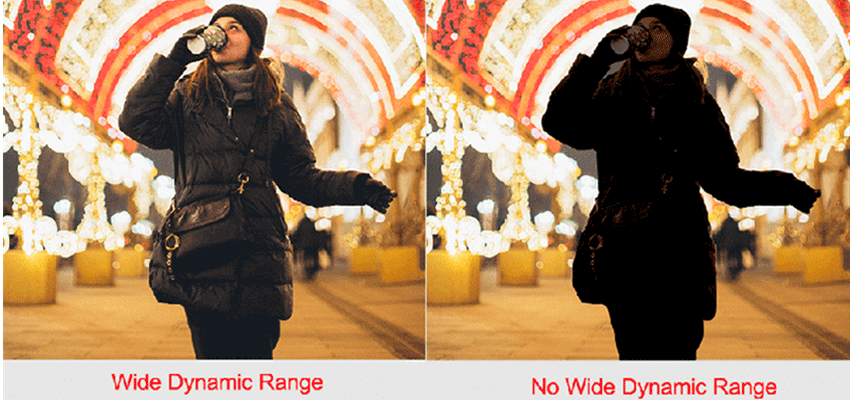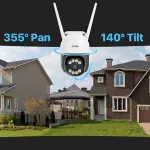Wide dynamic range (WDR) is a video technology that has significantly improved the quality of video footage across multiple industries in recent years. Although many users may not be familiar with the technology, they have likely witnessed the feature’s benefits while reviewing footage or shopping for security cameras.
WDR eliminates dark spots and glare in video footage, producing clear, detailed images even in extreme light conditions. By managing the light spectrum’s extreme levels, WDR ensures that the most intricate details are visible when reviewing or streaming video footage, ultimately improving CCTV cameras’ performance.
In the past, WDR was highlighted alongside other prominent features that could assist potential buyers in finding a suitable security camera for their needs. Since then, the technology has advanced significantly, offering users even more options to consider when selecting a security camera system.
At Zosi, we understand that choosing the right security camera can be daunting. That’s why we strive to ensure the security cameras we offer are equipped with advanced features such as WDR, so that you can rest assured that your security camera system provides optimal protection and peace of mind.
Contents
The basics of WDR
Choosing the right CCTV brand and technology can be challenging, given the variety of options and unique features available in the market. However, when it comes to WDR cameras, you can categorize them into two types, making it easier to select the right product for your needs.
HDR vs. WDR: Which is better?
When comparing HDR (High Dynamic Range) and WDR (Wide Dynamic Range), it’s essential to understand their specific characteristics and applications. The following table highlights some key differences and considerations between HDR and WDR:
| Criteria | HDR | WDR |
|---|---|---|
| Definition | HDR is a technique to reproduce a greater dynamic range of luminosity than standard imaging techniques. | WDR is a technology that allows a camera to capture and display a wider range of brightness levels in a single image. |
| Application | Commonly used in photography, displays, and video content creation to enhance image quality and detail. | Primarily employed in surveillance and security cameras to handle challenging lighting conditions, ensuring details in both bright and dark areas. |
| Processing Method | Combines multiple images with different exposures to create a composite image with enhanced details. | Utilizes various techniques, including different exposure levels and image processing algorithms, to capture details in a scene with varying lighting conditions. |
| Use Cases | Photography, cinematography, gaming, and multimedia content creation where visual aesthetics are crucial. | Surveillance and security applications where maintaining visibility in both bright and dark areas is essential. |
| Dynamic Range Coverage | Addresses a broad range of luminosity for artistic and visual appeal, but may not handle extreme variations as well as WDR. | Specifically designed to handle extreme variations in lighting, making it more suitable for surveillance scenarios with high contrast. |
| Intensity of Processing | Typically involves post-processing to merge multiple exposures, which may result in a delay in capturing the final image. | Real-time processing is crucial in surveillance, and WDR systems are designed to provide quick and seamless adaptation to changing lighting conditions. |
| Consumer vs. Professional | Commonly found in consumer electronic devices such as cameras and TVs for enhanced viewing experiences. | Predominantly used in professional surveillance systems where maintaining visibility in challenging environments is critical. |
| Cost Considerations | HDR-capable devices are widely available across various price points, making it accessible for consumer applications. | WDR technology is often implemented in specialized surveillance cameras, which may be priced higher due to their specific features and requirements. |
Ultimately, the decision between HDR and WDR should be based on your specific requirements and application needs. While HDR is ideal for enhanced visual aesthetics, WDR is tailored to tackle the challenges of surveillance environments where lighting variations are extreme.
Measuring wide dynamic range
Understanding how WDR technology works in varying environments is an essential factor in ensuring that it’s as effective as possible. Developing WDR requires a specific scientific approach to tackle the challenges posed by different lighting conditions and environments. While WDR may not always function correctly in extreme lighting conditions, it can help to reduce the environmental effects on the recorded footage.
The science behind it involves measuring illuminance and brightness (in decibels) to manage the lux, which refers to the light level at a given time of the day.
| Decibels | Darkest to Brightest Ratio |
| 10 dB | 20 |
| 100 dB | 40 |
| 1000 dB | 60 |
| 10000 dB | 80 |
| 100000 dB | 100 |
Measuring decibels is critical since it’s the industry standard for the kind of sensor a camera requires. Conversely, lux doesn’t require matching measurement but will match a given scenario. For instance, .2 to 1 lux is equivalent to a night with a full moon, 500 to 1000 lux is typically an office environment, and 100,000 lux represents direct sunlight.
This information is crucial for manufacturers to develop technology that suits normal environments. While our eyes are sensitive to a wide range of light, most security cameras aren’t unless equipped with WDR technology. Regular offices, rooms with windows, garages, and typical work environments typically use normal WDR to combat glare and dark spots. Meanwhile, areas like lobbies, corridors near outdoor entrances, or areas prone to car light beams require super-wide dynamic range cameras.
The Difference between normal and super wide WDR
The amount of illuminance that eyes and camera sensors can handle can be measured using decibels, as explained earlier. The primary difference between eyes, normal WDR, and super wide technology is how much illuminance each can handle. While the specific numbers can vary based on the lighting conditions, human eyes can handle approximately 80 to 110 decibels, normal WDR can deal with 60 to 72 decibels, and super-wide WDR can handle up to 144 decibels.
It’s essential to note that even though digital and true WDR operate differently, they’re measured similarly, as mentioned above. While each may handle light differently, normal and super-wide versions of both digital and true WDR can be used depending on the specific environment and lighting conditions.
Should WDR be on or off CCTV?
The decision to enable or disable WDR (Wide Dynamic Range) on a CCTV camera should be based on carefully assessing the lighting conditions and environment where the camera is installed. Here are some essential considerations to help you decide whether to use WDR:
- High Contrast Environments: Enable WDR when capturing areas with both intense brightness and deep shadows. WDR ensures that details in both well-lit and poorly-lit areas are captured, effectively maintaining visibility in both extremes.
- Indoor vs. Outdoor: For outdoor surveillance where natural light varies significantly throughout the day, WDR can be beneficial to handling the changing lighting conditions. Indoor environments may not always benefit from WDR, mainly if the lighting is consistent and controlled.
- Specific Security Concerns: WDR is essential when specific security concerns arise in areas with challenging lighting conditions. For example, a strong backlit entrance requires WDR to capture vital details.
- Testing and Optimization: Test the camera with WDR enabled and disabled and observe the differences in image quality. Adjust the settings based on the surveillance site’s specific needs.
- Performance Impact: Enabling WDR may affect real-time processing, so evaluate whether the camera can handle the delay or alternative performance impact.
- Power Consumption: WDR may consume more power, so consider whether power efficiency is a concern and whether the benefits of WDR are necessary for the specific surveillance scenario.
- Cost Considerations: WDR-capable cameras may be more expensive than cameras without this feature, so evaluate whether the increased cost aligns with the specific surveillance application’s needs.
In summary, the decision to enable or disable WDR on a CCTV camera should be based on assessing the lighting conditions and the security requirements of the specific environment. Regular testing and optimization can ensure that the camera settings are configured to provide optimal image quality for surveillance purposes.
Why toggle WDR?
Wide dynamic range (WDR) is an invaluable technology that helps combat glare and dark spots in video feeds, improving overall footage quality. However, it’s essential to keep in mind that enabling WDR may require more data in a given recorder or server, especially with true WDR technology, which captures multiple images per frame before combining them to make the best result.
Additionally, not every vantage point or camera in your system requires WDR. If you have multiple supportive cameras on the same shot or surrounding area, you may not need WDR at every vantage point, which can help reduce the overall storage requirements and server usage.
Improve your surveillance with WDR cameras!
At Zosi, we highly recommend using WDR (Wide Dynamic Range) technology for your security camera system. WDR vastly improves the performance of each CCTV product, making surveillance more efficient and effective at all times of the day. WDR technology addresses the problem of glare and low light conditions, ensuring that your camera captures clear and detailed images.
Moreover, WDR technology is continually advancing, with new developments enhancing its performance and ensuring that the CCTV industry’s needs are met. When selecting a security camera system with WDR technology, you can be confident that you’re making a future-proof investment with cutting-edge technology.
Best WDR Security Camera/System Recommends
1. Best WDR Outdoor Security Camera – 1NC-298
8MP PTZ Wifi Outdoor Camera With Dual Lens - 1NC-298
- 4MP+4MP Dual Lens
- Dual Lens Achieves Ultra-wide Field Of View
- AI Person Detection and Auto Tracking
- Starlight Color Night Vision
- Smart Motion Alerts Push
- Two-way Audio & Customize Voice Alerts
- SD Card Storage & Cloud Storage
Get more details from the WDR security camera system reviews here.
Below is a video shared by a user of 1NC-298.
2. Best WDR PTZ Security Camera – 1NC-296
C296 - Pan Tilt IP Security Cameras
- 4K Ultra HD/5MP Super HD
- Starlight Color Night Vision
- Pan & Tilt
- PoE/WiFi Connection
- Light & Siren Alarm
- Upgraded AI-Powered Detection
- 2-Way Audio

